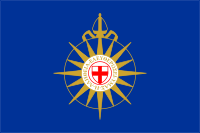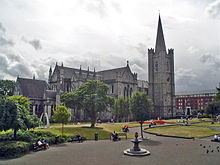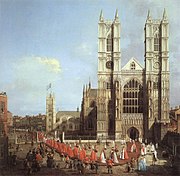History of the Anglican Communion
| Anglican Communion |
|---|
 |
| Part of a series on Anglicanism |
| Organisation |
| Theology |
|
| Liturgy and worship |
| Other topics |
|
|
The history of the Anglican Communion may be attributed mainly to the worldwide spread of
Origins

| Part of a series on the |
| History of the Church of England |
|---|
 |
The only
Although
The
The attempt to impose in Scotland a Prayer Book on the English model, drove the three kingdoms into
In the 18th and 19th centuries, divines of the Church of England increasingly differentiated their faith from that of the Protestant churches. Controversy broke out into the open after 1829, with the removal of religious restrictions on political rights in the United Kingdom, following which elected members of the UK Parliament (the legal authority in England for definitions of religious faith), might include both Roman Catholics and Dissenters. The
As Britain's worldwide colonial empire grew, the Church of England began to spread with it. But at first no bishops were sent overseas; all colonial churches reported back to the Bishop of London. At the time of the American Revolution, there had already been considerable American demand for a local bishop; and after that event the Church of England in the new United States certainly needed to organize itself on a local basis.
Anglicanism in the colonies
The first Anglican service in North America was conducted in California in 1579 by the chaplain accompanying Sir Francis Drake on his voyage around the globe. The first baptisms were held in Roanoke, North Carolina, by the ill-fated Roanoke colony. The continuous presence of Anglicanism in North America, however, begins in 1607 with the founding of Jamestown, Virginia. By 1700 there were more than 100 Anglican parishes in British colonies on the mainland of North America, the largest number in Virginia and Maryland. The American War for Independence resulted in the formation of the first independent national church in the Anglican tradition.
The 1609 wreck of the flagship of the Virginia Company, the Sea Venture, resulted in the settlement of Bermuda by the company. This was made official in 1612 when the town of St. George's, now the oldest surviving English settlement in the New World, was established. It is the location of St. Peter's Church, the oldest-surviving Anglican church outside of the British Isles (Britain and Ireland) and the oldest surviving non-Roman Catholic church in the New World, also established in 1612. It remained part of the Church of England until 1978 when the Anglican Church of Bermuda was formed. The Church of England was the state church in Bermuda and a system of parishes was set up for the religious and political subdivision of the colony (they survive, today, as both civil and religious parishes).
The parish of
On August 12, 1787,
Soon afterwards, in 1835 and 1837, the sees of
The plan was taken up with enthusiasm and, in 1841, the bishops of the
It was only very gradually that these dioceses acquired legislative independence and a determinate organization. At first, sees were created and bishops were nominated by the crown by means of letters patent; and in some cases an income was assigned out of public funds. Moreover, for many years all bishops were consecrated in England, took the customary "oath of due obedience" to the Archbishop of Canterbury, and were regarded as his extraterritorial suffragans. But by degrees changes were made on all these points.[9]
America
In 1783 the parishes of
The Protestant Episcopal Church held its first General Convention in 1785, and organized using a system of state conventions in place of dioceses. They adopted a constitution and canons and approved an American version of the Book of Common Prayer in 1789 in Philadelphia. William White, who had served as presiding officer of General Convention in 1785 and 1786, was also elected presiding officer of the 1789 convention. He was the first bishop to preside over the convention. When in a second session of the 1789 convention, Bishop Seabury was seated and the New England churches acceded to the constitution. The bishops then withdrew and Bishop Seabury became the first bishop to preside over a separate House of Bishops. The American church officially adopted the term "diocese" in 1839 with the formation of a second diocese in the state of New York.
Provincial organization
Local conditions soon made a
- The creation of diocesan and provincial synods, the first diocesan synod to meet being that of New Zealand in 1844, while the formation of a provincial synod was foreshadowed by a conference of Australasian bishops at Sydney in 1850;
- Towards the close of the 19th century the title of archbishop began to be assumed by the metropolitans of several provinces. It was first assumed by the metropolitans of Canada and Rupert's Land, at the desire of the Canadian general synod in 1893; and subsequently, in accordance with a resolution of the Lambeth Conference of 1897, it was given by their synods to the bishop of Sydney as metropolitan of New South Wales and to the bishop of Cape Town as metropolitan of South Africa. Civil obstacles delayed its adoption by the metropolitan of India.[9]
Freedom from state control
By degrees, also, the colonial churches were freed from their rather burdensome relations with the state. The Church of the West Indies was disestablished in 1868.[9] Other colonial churches followed suit over the next few decades.
In 1857 it was decided, in Regina v. Eton College, that the Crown could not claim the presentation to a living when it had appointed the former incumbent to a colonial bishopric, as it does in the case of an English bishopric. In 1861, after some protest from the crown lawyers, two missionary bishops were consecrated without letters patent for regions outside British territory:
In 1863 the privy council declared, in Long v. The Bishop of Cape Town, that "the Church of England, in places where there is no church established by law, is in the same situation with any other religious body." In 1865 it adjudged Bishop Gray's letters patent, as metropolitan of Cape Town, to be powerless to enable him "to exercise any coercive jurisdiction, or hold any court or tribunal for that purpose," since the Cape colony already possessed legislative institutions when they were issued; and his deposition of Bishop Colenso was declared to be "null and void in law" (re The Bishop of Natal). With the exception of Colenso the South African bishops forthwith surrendered their patents, and formally accepted Bishop Gray as their metropolitan, an example followed in 1865 in the province of New Zealand.[9]
In 1862, when the Diocese of Ontario was formed, the bishop was elected in Canada, and consecrated under a royal mandate, letters patent being by this time entirely discredited. And when, in 1867, a coadjutor was chosen for the bishop of Toronto, an application for a royal mandate produced the reply from the colonial secretary that "it was not the part of the Crown to interfere in the creation of a new bishop or bishopric, and not consistent with the dignity of the Crown that he should advise Her Majesty to issue a mandate which would not be worth the paper on which it was written, and which, having been sent out to Canada, might be disregarded in the most complete manner."[9]
And by the turn of the century the colonial churches were entirely free in this matter. This, however, was not the case with the Church in India. Here the bishops of sees founded down to 1879 received a stipend from the revenue (with the exception of the bishop of
Autonomy
By degrees, also, the relations of colonial churches to the Archbishop of Canterbury changed. Until 1855 no colonial bishop was consecrated outside the British Isles, the first instance being Bishop MacDougall of Labuan, consecrated in India under a commission from the Archbishop of Canterbury; and until 1874 it was held to be unlawful for a bishop to be consecrated in England without taking the suffragan's Oath of Due Obedience. This necessity was removed by the Colonial Clergy Act of 1874, which permitted the Archbishop of Canterbury at his discretion to dispense with the oath.[9]
But the most complete autonomy did not involve isolation. The churches were in full communion with one another and acted together in many ways; missionary jurisdictions and dioceses were mapped out by common arrangement and even transferred if it seems advisable; e.g., the Diocese of Honolulu (Hawaii), previously under the jurisdiction of the Archbishop of Canterbury, was transferred in 1900 to the
Though the See of Canterbury claims no primacy over the Anglican Communion analogous to that exercised over the
Lambeth Conferences
The conference of Anglican bishops from all parts of the world, instituted by Archbishop Longley in 1867 and known as the
An even more imposing manifestation of this common life was given by the great
As the result of negotiations and preparations extending over five years, 250 bishops, together with delegates, clerical and lay, from every diocese in the Anglican Communion, met at
Bonn Agreement
In 1931 the Anglican Communion and the
- Each communion recognises the catholicity and independence of the other and maintains its own.
- Each communion agrees to permit members of the other communion to participate in the sacraments.
- Inter-communion does not require from either communion the acceptance of all doctrinal opinion, sacramental devotion or liturgical practice characteristic of the other, but implies that each believes the other to hold all the essentials of the Christian faith.
With this new inter-communion cross-episcopal ordinations began, further endorsing the apostolic succession within Anglicanism.
Modern history
Meetings began in 1937 about inter-communion between the
See also
References
- ISBN 0-7139-9370-7.
- ISBN 0-7139-9370-7.
- ISBN 0-7139-9370-7.
- ISBN 0-7139-9370-7.
- ISBN 0-7139-9370-7.
- ISBN 0-7139-9370-7.
- ^ a b Chisholm 1911, p. 19.
- ^ Chisholm 1911, pp. 19–20.
- ^ a b c d e f g h i j Chisholm 1911, p. 20.
- ^ Chisholm 1911, pp. 20–21.
- ^ a b Chisholm 1911, p. 21.
- This article incorporates text from a publication now in the public domain: Chisholm, Hugh, ed. (1911). "Anglican Communion". Encyclopædia Britannica. Vol. 2 (11th ed.). Cambridge University Press. pp. 19–21.
- The American Church and the Formation of the Anglican Communion, 1823-1853 1962 article by Robert Semple Bosher
